
An Electrifying Adventure!
I have a very healthy respect for electricity. In my early 20s, having been told that the breaker was turned off to the plug-in I was working on, I then experienced the joy of flight!
The breaker that was labelled as belonging to that plug-in was incorrectly labeled.
That experience immediately prompted a thorough testing of all the plug-ins and light switches in that house, and an extremely detailed laminated breaker reference was created, and permanently mounted on the door of the breaker box. Also, following that experience, I took the path of least resistance (literally), and turned off the main breaker anytime I was working on anything that had to do with electricity in that house, and in every house I lived in following it.
One of the first things I did in every single house I lived in after that one, was to thoroughly map the breaker/outlets/switch correlations, create detailed, dated laminated breaker reference sheets which were then mounted next to the breaker boxes. Anytime a renovation changed any of the electrical wiring a new dated laminated breaker reference sheet was prepared and mounted. Many people will say this was overkill, but it may well have saved me (and others) from BEING killed.
When I was planning the electrical wiring for The Dragons Nest, I did my usual thorough research. The local building codes may vary from location to location, but most are based on model codes that are created on a national or international level by committees or councils consisting of recognized trade professionals. I used the following Electrical Codes:
1. Electrical Code Simplified- House Wiring BC Guide; Publisher:P.S.Knight,ISBN:0920312403/ISBN13:9780920312407
2.Canadian Electrical Code, Part I (24th edition), Safety Standard for Electrical Installations
3. INTERNATIONAL BUILDING CODE and INTERNATIONAL RESIDENTIAL CODE, as the ICC offers limited free access to lengthy portions of both the IBC and IRC in its public access section of the website. This is the best source for free information on the codes.
The International Code Council (ICC), is an organization responsible for the International Building Code (IBC) and the International Residential Code (IRC) which are codes governing commercial and residential building and remodeling practices, respectively, and are the basis for most local code regulations.

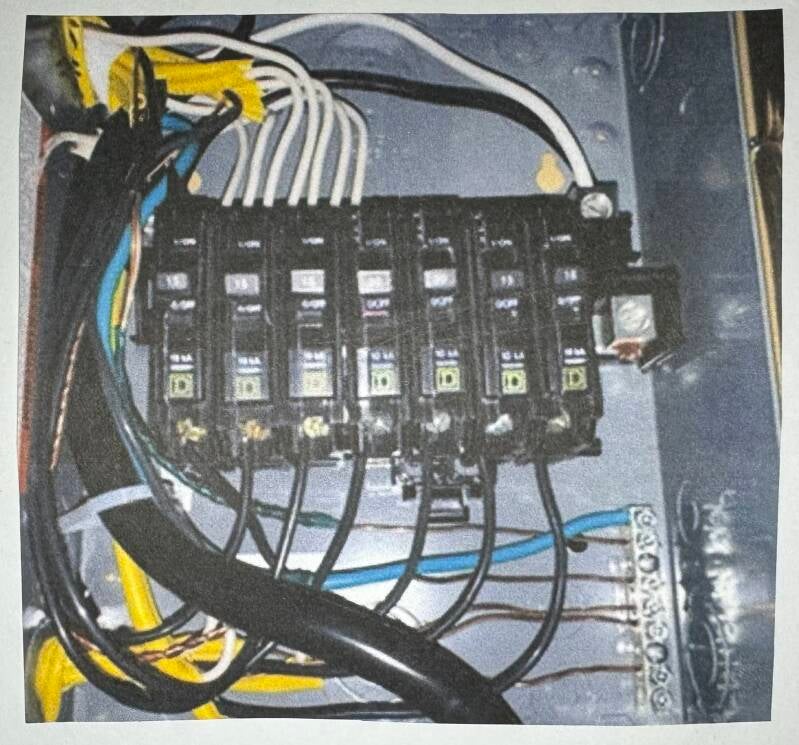

My procedure and practice when handling electrical wiring was according to code.
I chose to wrap a piece of red tape around the ‘hot’ wires coming from the breaker box — the ones supplying the electricity to the device, so I could tell at a glance which was the “hot/live” wire.
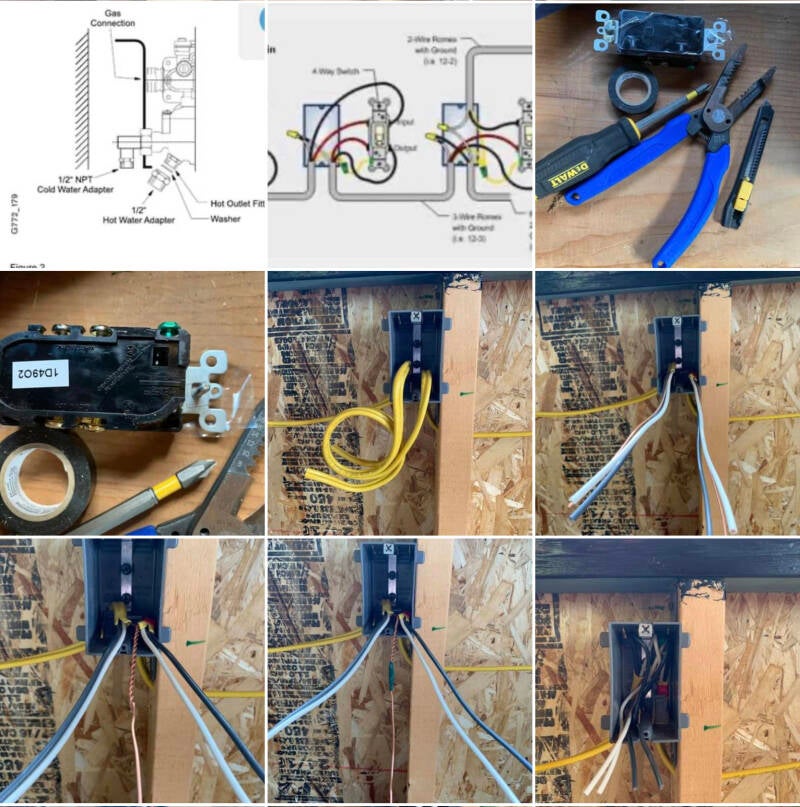
The traveller wire (on the left in the photo), carries electricity to another box — a receptacle, light, fan or even another switch (for 3-way and 4-way switches)
I pigtail all my ground wires (the bare copper ones without plastic coating) and wrap a bit of green electrical tape at the base of the twist. At a glance this tells me there is a pigtail of ground wires there.
My white neutral wires are ‘pigtailed’ together into a new style of wire connector, which takes the place of the twist-on marretts, and which I quite like!
You can also see my ‘hot’ incoming electrical wires in their little red ‘dresses’.
The ‘hot’ goes to a brass screw but sometimes a switch has a black screw as well. The hot line goes on the black screw in that case and the brass screw takes the traveller carrying electricity to the next box. Some devices allow you to push the wire into a hole and then tighten it down. Some require you to make a little hook around the screw and screw that down.
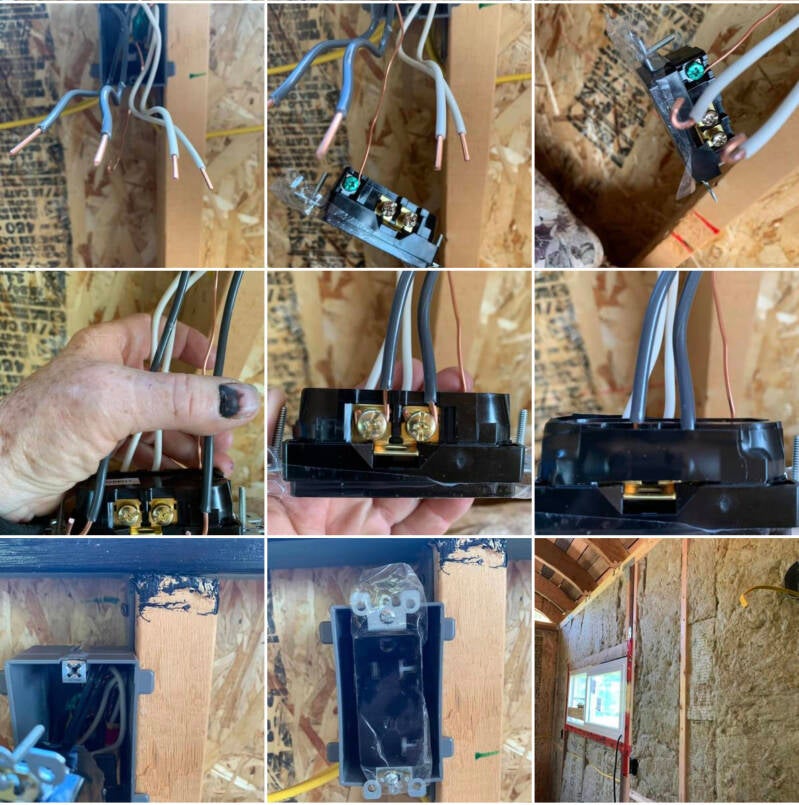
My solar system was purchased after over a year of intensive research, watching and reading reviews and through email and telephone conversations with the reps of several companies.
There are a lot of 'systems' out there, but I chose The Point Zero Titan for its ease of set-up and operation.
The Titan 1000 Rigid Kit I purchased came complete five 200 watt rigid solar panels and one lithium battery pack, the original kit is the perfect size for running basic essentials including a refrigerator, lights, computer or laptop, tv, and other small electronics for an extended period of time. Utilizing the 1000 watts of solar, the Titan will charge the single battery from 0% to a full in about four hours of good solid sunshine (temperature does not matter as long as there is sun).
I augmented the original kit with an additional 5 x 200w panels, and additional stackable batteries. It still only takes four hours to charge the additional batteries with the extra solar panels.
Using only quality and efficient components, the Titan is the most reliable and versatile system on the market. Here are some of the key features that put it in a class of its own:
Removable Expandable Lithium Ion Battery:
This innovative approach will give you greater portability and flexibility in what you can power with your solar generator. By simply adding more battery packs you can expand or replace your batteries quickly and easily. By separating the battery from the other components, you can easily carry each component.
2000 Watt Hour Lithium Battery:
With a full 2000 watt hours usable power, the Titan battery is one of the largest lithium battery capacities you can find in a portable solar generator. It’s nearly twice the capacity of similar systems on the market.
3000 Watt High Efficiency Inverter:
Pure sine wave inverter is extremely powerful- twice as powerful as comparable solar generators! It is also extremely efficient, with a no load power draw of as low as 5 watts, and efficiencies up to 92%! Generally, the larger the inverter the more power it uses just to run-like a large truck burns more gas than a small car. This is comparable to having a 500 hp race car getting better fuel mileage than a geo metro.
Dual MPPT Charge Controller:
Most solar generators use cheap, low quality charge controllers that cannot step the voltage down to produce high amps. Most don’t allow for voltages over 30-50 volts. The Titan on the other hand, can take up to 145 volts! This means your solar panel wires will have very low amps running through them making them much more efficient (they will be cool to the touch where others will feel hot). It also makes wiring up your solar panels much easier and safer.
Super Fast AC Charging, 400 Watts Standard:
A very handy powerful 14A AC charger that can charge your battery pack in around 5 1/2 hours comes with the kit. You do have an option to add a 25A charger to charge in 3 hours, and two chargers (if you have more than one battery).
External Battery Compatibility:
The Titan solar generator was designed to be compatible with nearly every 24V battery type. My Titan Solar Generator uses Lithium Ion removable and stackable batteries that have a voltage range of 20V to 29.4V (only charged to 29.2V). It also works perfectly with 24V LiFePo4 batteries (19.2V to 29.2V) or led acid batteries (20V to 29.2V). As you can see there is virtually no difference between the 3 batteries voltage range, so they can be used together without any changes to the charging profile and without damaging any battery.
The Titan battery is very easy to stack on top of another battery due to its universal connectors. There’s no way to stack it incorrectly. The battery can be turned 180 degrees and will still plugin just fine without damaging anything. This takes away any user error and increases safety for users. This special stacking method can also be stacked horizontally if needed. It is not required to stack the batteries vertically. Special cables can be purchased to allow a secondary battery or even the main battery to be placed in a different location. This makes it easier for some RV and Van users to have the battery in one location and the inverter in another.
One of my favourite YouTubers is Will Prowse, a self taught expert in all thing solar. He did a wonderful stress test on the Titan system and shared it in the video at this link:
A note on Panel Capacity here... I use ten 200W panels to generate 2000W of power when operating at peak capacity. Peak panel capacity is the amount of power a panel is RATED to be able to PRODUCE in a day. My Solar Array (the 10 solar panels I have connected together) is capable of producing 2,000w of power in an hour of good sun hitting the panels exactly right. In the summer my system provides me unlimited power. In the rainy winter months an EXCELLENT day of sun will be 4hrs x 2,000w = 8,000wh of power POTENTIAL daily. In truth, the solar panels can only produce the maximum potential under perfect conditions. Also power is used up by the friction of travelling through electrical cabling. So, as the watt hours (wh) of electricity being produced by the solar panels travel through the electrical wiring to whatever it is trying to power or to an electrical storage system of batteries, a percentage of the power is used up, meaning that even in the very best conditions possible, the projected potential of power the panels are RATED to produce can never be realized. The further away the Solar Panels are from whatever is being powered, the greater the lost in transit.
I have 4 batteries in total now (8,000wh potential) and so need one day of excellent sunlight to fully charge my power storage system. My battery storage system system will supply my electricity needs for about three days on a full charge, meaning if the weather is overcast for two days in row, I need to use a generator on the third day to help my system recharge, or sooner if my electrical consumption is higher than usual, for instance when I'm doing a lot of baking. Calculating the wh (Watt Hour) demand of your electrical usage will help you choose a solar panel array to meet your needs.

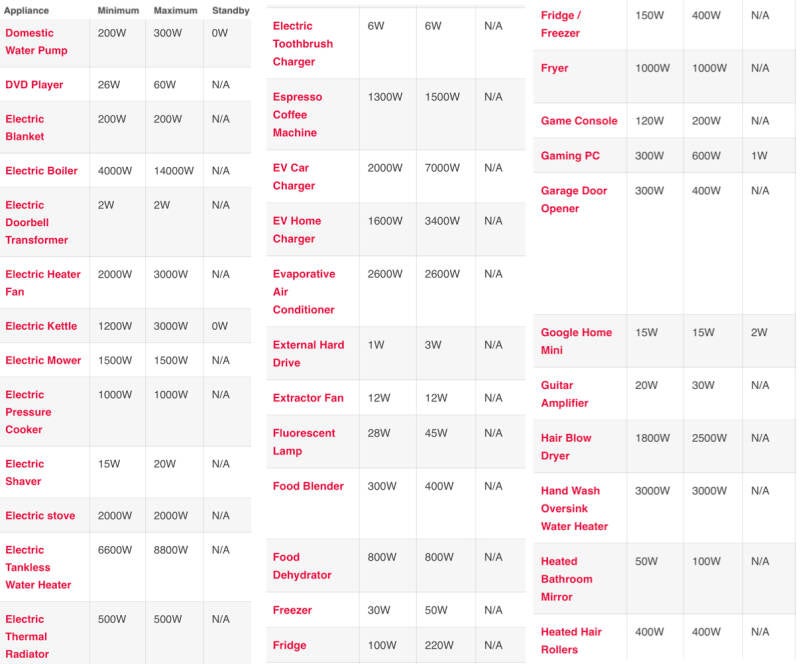


Another provider of solar power systems is Streamline Renewables
On their website they offer solar panel kits in three sizes. Streamline Renewables offers to meet your off-grid solar needs, for both new builds as well as existing structures.
Their website says they streamline the process and manage every detail from conception, to design, installation and everything in between.
Their solar systems are custom designed based upon your needs, budget, and schedule, and they manage any permits and applications needed for your project.
Unlike grid-tied solar PV systems, which rely on hydro resources to power your residence or commercial property when your system is not generating electricity, an off-grid solar PV system works completely independent of the utility grid. Like the system I use, those by Streamline Renewables systems generate enough electricity to meet a property’s energy consumption, or to reduce reliance on generators powered by fossil fuels.
I like their 430W solar panels!
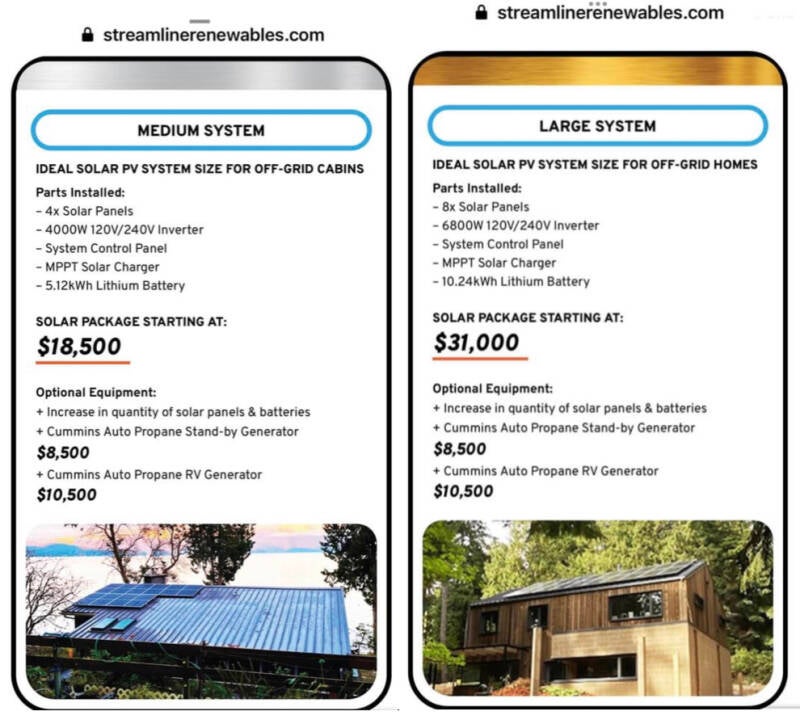
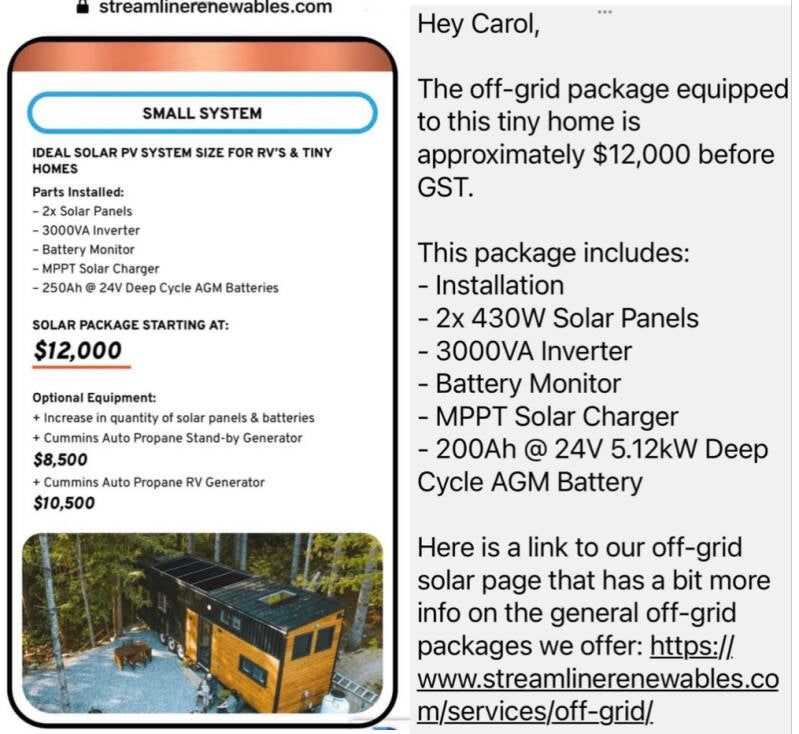
I thoroughly researched back-up generators. I knew from the research into my solar panels that I might occasionally need a back up generator to charge the batteries on my system if we had too many gray days in a row. I wanted *clean* power, so was looking at inverter generators in particular. There are a lot of them out there!
I watched hundreds of YouTube video reviews, read every written review I could find on the brands and narrowed my choices to, and finally decided on, the Firman WH02942 Dual Fuel Inverter Generator. My main deciding criteria were 1. Quality manufacturing with decent warranty 2. Price 3. Noise it doesn't make.
Info from Firman Website *****The FIRMAN WH02942 Inverter generator features 3200 starting watts and 2900 running watts. Power is supplied by our Max Pro Series 171cc FIRMAN engine which runs cool and efficient thanks to its Phoenix Fat Head Block. Our Whisper Series muffler keeps the Wh02942 running a quiet 58 decibels – well below the standards set by the National Parks Service, and our spark arrester has been approved by the USDA Forest Service. The 1.8-gallon fuel capacity provides a whopping 9 hours of run time. Starting is simple with the reliable FIRMAN electric start system. (source: Firman) *****
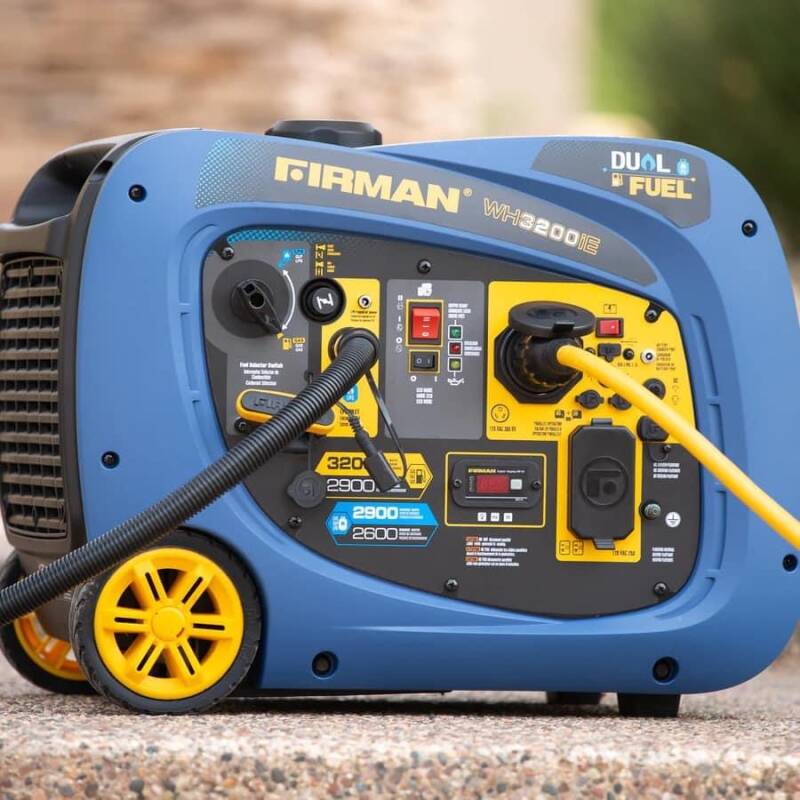
Founded in 1999, Firman Power Equipment is a company with a short, but established history in the power equipment industry. Based in Arizona, the company offers an immense range of products, including power tools, automotive equipment, storage utilities, work wear, but most importantly, a wide selection of generators of all sizes, designs and outputs.
https://youtu.be/6GAndFHR1_g
A nice *average guy* video, which shows the unboxing and first test runs of the generator. He tries to charge his electric vehicle and apparently if you use an additional grounding apparatus () it over-rides the floating ground most generators have, and makes it possible to charge an electric vehicle with this generator.
https://youtu.be/BrfRlADS798
A more polished and professional review video, and a really impressive sound test segment.
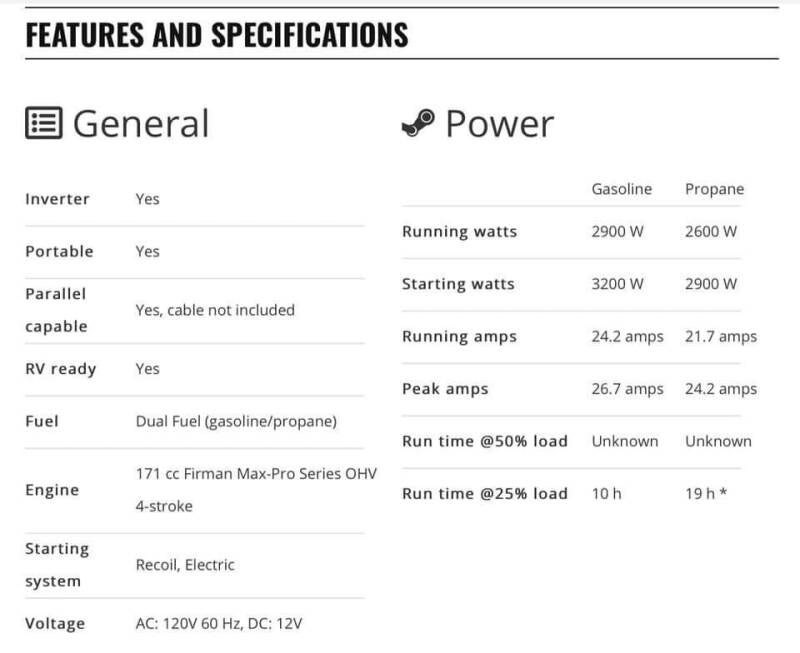
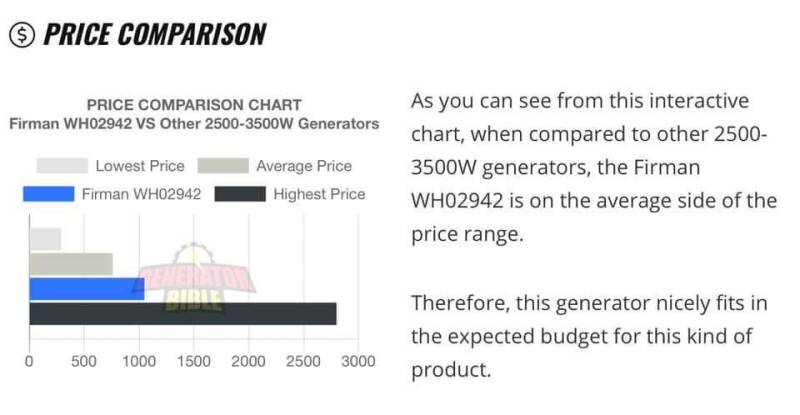
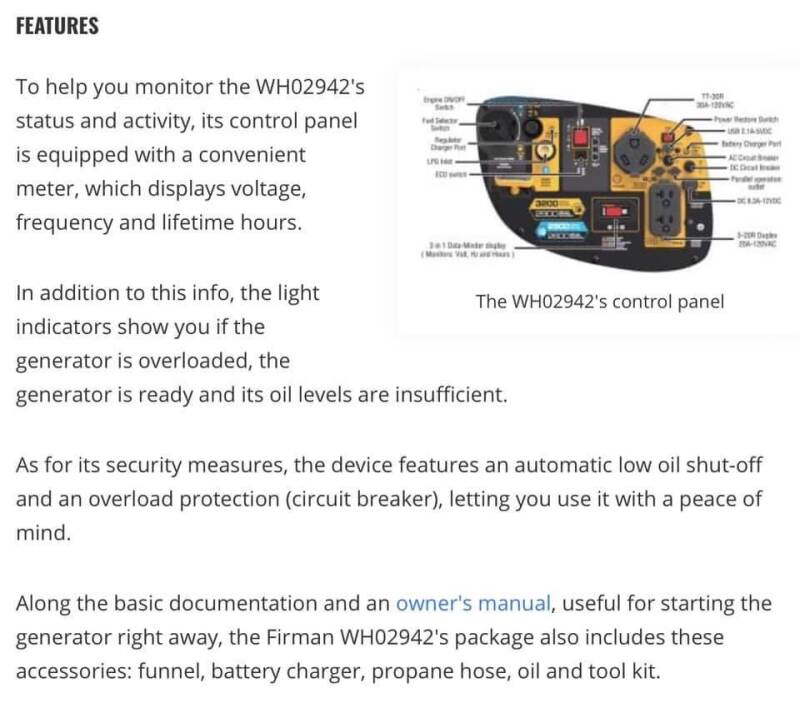

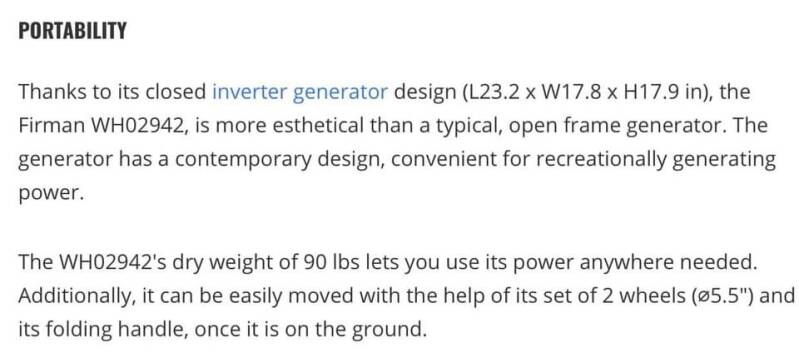
I bought mine through COSTCO, as the price was the best at the time of purchase. It's a bit heavy, but alone I can still manage to get it into my vehicle.
In three years I have spent $87 on repairs on this little generator — something in the carburetor stuck and the pull cord frayed and needed to be replaced. In January 2024 I finally got the electric start repaired and it's BRILLIANT, and has made me SO happy!

Add comment
Comments